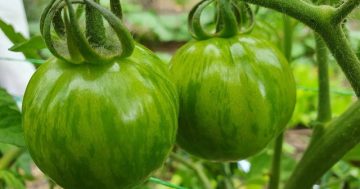
Covering your plants can increase the temperature of the soil. Photo: Wynlen House.
Take a good look at your herb garden. It is probably looking very poorly.
Chives will have died back, as will oregano, possibly leaving dried stalks that need to be trimmed off. Sorrel will be a patchwork of yellowing leaves, the chervil will have almost disappeared, and both thyme and rosemary will be looking very ragged and leggy.
If you still have some parsley, it too will be suffering, showing clumps of yellowing leaves. While yellowing can be caused by nutrient deficiencies such as nitrogen and magnesium, in these cases, partial dieback and yellowing are most likely due to cold stress experienced in winter weather.
There is not much to be done with the parsley plant. Technically, it is biennial. However, it does not often survive through winter in cool/cold climate gardens. It is best to treat it as a perennial and plant anew in late spring.
Unfortunately, sage is unlikely to survive the winter, particularly if it is growing in the southern part of our cold climate region, although it is a perennial in warmer climates.
Once again, it may be best to treat sage as a perennial and plant anew in late spring. Rosemary requires a bit of extra care, but generally, it is pruned after flowering in spring so it can be left alone now.
Do take the time to trim off all the dead stalks and halve your oregano plant. It is as simple as using a spade to cut the root system, reducing the size of the plant’s root base. Fertilise when finished with a good, complete liquid fertiliser or well-composted manure. This will rejuvenate the plant and make it ready for spring growth.
Treat thyme and sorrel in much the same way, even if they haven’t died back quite as much in the cold. It is remarkable how well the herb plants generally recover from such rough treatment.

Thyme responds well to rough treatment. Photo: Wynlen House.
Another August job to get done is fertilising the garlic. In a wet, cold and now windy winter, you often see yellowing or some purpling of the tips of the leaves. Regular fortnightly feeding with a nitrogen-boosted seaweed-based liquid fertiliser is very helpful if the ground is not too wet. A sprinkling of complete organic pelleted fertiliser around the plants can also be added.
This is also the time of year to start renewing your garden beds to get ready for the late spring and summer plantings. The weeds that have been growing happily through June and July are now getting themselves ready for seeding and spreading as soon as the soil temperature begins to warm.
Plants like onion weed, nut grass or crows foot grass should not be placed in your compost. They can be put through the chooks and disposed of in the green waste collection, or they can be turned into compost tea, which will destroy them and provide a liquid fertiliser and conditioner for the garden.
A weed or compost tea is another way to recycle green garden waste into beneficial inputs for your garden. Ideally, however, the making of a compost tea requires some heat as well as a little aeration to ensure that the extraction of nutrients and microbial growth is optimised and safe. Given it is still winter, this is an activity perhaps left until mid-summer unless, of course, you have a cauldron or old copper in the garden.

Your sorrel is probably looking a little yellow at the moment. Photo: Wynlen House.
Garden spaces that have been producing veggies through a season or more get compressed over time. The soil needs to be aerated to allow it to access oxygen and enable good water penetration. Gentle “working of the soil” is recommended to develop and maintain good soil structure. This can be achieved very simply with a garden fork.
Amendments need to be added to ensure that all the major nutrients essential for plant growth are available. This includes potassium, nitrogen and phosphorus, along with calcium, magnesium and sulphur.
Blood and bone contains nitrogen, calcium and phosphorus and is applied at the standard rate of application according to the label.
A Dolomite/lime mix provides calcium and magnesium. A half-cup measure (about 125 grams) per two square metres. This is not aimed at changing pH but at meeting the calcium and magnesium requirements of plants. Likewise, with powdered yellow sulphur, a quarter cup per square metre. This will not impact the pH of the soil. A complete pelleted organic fertiliser such as Seamungus can also be added according to the directions on the label.
Do check on the pH of compost.
Often, bulk purchases of landscaping compost are too fresh, and the pH is often very alkaline and won’t be suitable for the plants. We are often asked how much compost should be added to beds. The more you have, the more you can add. The minimum rate is one standard bucket per square metre. Well composted animal manure can also be added at about the same rate. Adding fresh horse, cow or chicken manure will burn plants, and either should be composted or, if added directly to a garden bed, should be left to “mature” for four to eight weeks before it goes on the bed.
Finally, have you checked how plants are growing under your frost mitigation system? It is surprising how much difference a few degrees makes to plant growth. Under our system, the soil temperature is at least two degrees warmer on average than the uncovered soil, and the growth, especially of the English spinach, cabbage, coriander and broccolini planted under the agricultural cloth, is much more lush.
Bronwyn Richards and Helen Lynch run Wynlen House Artisan Village Farm and Learning Centre, a small village organic market garden in Braidwood, NSW. Since 2006 they have grown and sold fresh vegetables, eggs, preserves and garlic, and teach others to do the same.





















